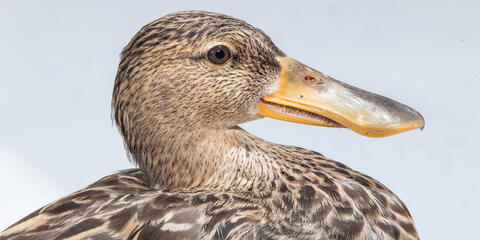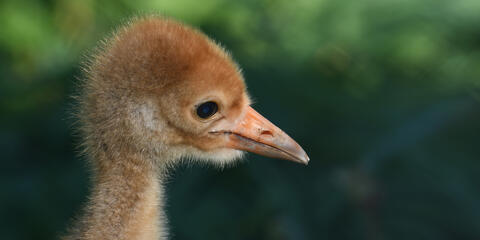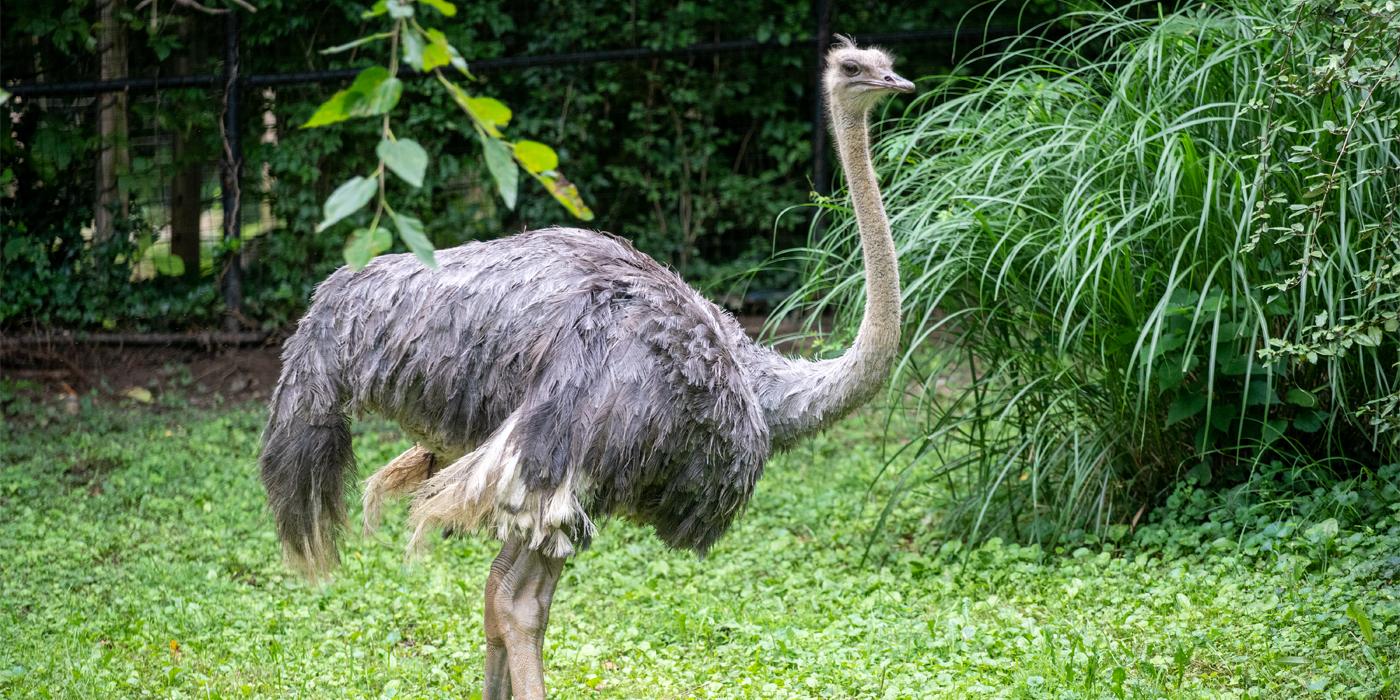Physical Description
Ostriches are tall, flightless birds with long necks, muscular legs, and claw-like feet. Their bulky bodies are covered in large, puffy feathers; adult males have black feathers and white tails, while females are mostly covered in brown feathers. Their necks and heads are covered in fine, wispy feathers, and their legs are not feathered. Ostriches have thick, muscular thighs and legs, with two-toed feet ending with a long, sharp claw on each toe. They have big eyes—about 2 inches (5 centimeters) wide, which is the largest of any bird—and fine eyelashes that help protect their eyes from dust and sand.
Ostriches have large wings, but they do not use them to fly. Instead, they stick out their wings while running, which creates a rudder-like effect and helps the ostrich change direction at high speed. Ostriches also flap and fan their wings to help keep themselves cool in hot weather.
Scientists have seen ostriches run continuously at speeds of 30-37 miles (48-59 kilometers) per hour and sprint up to 43 miles (69 kilometers) per hour.
Size
Adult ostriches weigh between 200 and 300 pounds (90-136 kilograms), about half the weight of a motorcycle. Including their necks, a fully-grown ostrich can measure up to 9 feet tall, though females tend to be shorter than males.
Native Habitat
Common ostriches are mostly found in the grasslands, savanna and shrublands of southern and eastern Africa. They are also quite capable of surviving in deserts and open woodlands.
Lifespan
In the wild, ostriches live up to 30-40 years. In human care, some ostriches can live for almost 70 years.
Communication
Ostriches use a variety of vocalizations to communicate with each other, including chirps, hisses, growls and honks. Male ostriches can also make a booming sound by filling a special sac in their throat with air. These low-pitched noises—which sound almost like a lion’s roar, but more muffled—can travel across great distances. They make these booming calls during the breeding season to let females know they are ready to mate.
Food/Eating Habits
Ostriches are omnivores, although most of their diet is plant-based. They mainly eat leafy greens, flowering plants, roots, grasses and succulents. They also occasionally feed on fallen fruit or small animals such as mice, lizards, frogs, grasshoppers and locusts.
Ostriches do not have teeth—like many other types of ground-dwelling birds, they swallow sand and pebbles to help grind down food in their stomachs.
The Smithsonian’s National Zoo’s ostrich eats produce, insects, and pellets fortified with vitamins and nutrients. Her favorite foods are leafy greens, such as romaine, kale and collards.
Sleep Habits
These birds are awake in the daytime and are most active early in the morning and late in the evening.
Social Structure
Wild ostriches live by themselves or in small groups called herds. A herd of ostriches usually has one dominant male and one dominant female. Herds usually have about a dozen individuals, but some especially large groups hold up to 100 ostriches!
Reproduction and Development
Ostriches are polygamous, meaning one dominant male will mate with one or more females within his territory. Males and females participate in an elaborate courtship ritual before breeding. After finding a potential mate, males will perform a dance where they bow, flap each wing in turn, shake their tail and stomp on the ground to impress the female.
Ostrich nests are communal; several ostriches lay their eggs in the same nest. Then, one male and one female take turns incubating the eggs. Each female lays between seven and 10 eggs at a time, so nests may contain up to 50 eggs. Ostrich eggs are 6 inches (15 centimeters) long and weigh up to 3 pounds (1.4 kilograms).
While tending to their nests, ostriches stick their heads low to the ground when turning over their eggs—this behavior may account for the popular myth that ostriches bury their heads in the sand when they sense danger.
After about 45 days of incubation, the chicks hatch from the eggs. When they first hatch, baby ostriches are roughly the size of a chicken, and are covered in soft, fuzzy, tan-colored plumage with brown spots on their heads and necks. These chicks grow incredibly quickly—about 1 foot per month! They reach the size of their parents after about 6 months, but do not reach sexual maturity until they are about 3-4 years old.
Conservation Efforts
Wild populations of the common ostrich have declined but, in general, the species is not considered threatened. One subspecies, the Arabian ostrich, became extinct in the 1960’s; another, the North African ostrich, is critically endangered. Habitat loss and overhunting are the main sources of population decline.
Ostriches are raised on farms for meat as well as for their feathers, which are prized for decoration, clothing, and headgear. Predators in the wild include cheetahs, lions, leopards and hyenas.
Help this Species
- Be a smart consumer! Avoid animal-skin products, even those marked “faux,” to ensure you’re not contributing to the illegal hunting of this species.
- Practice ecotourism by being an advocate for the environment when you’re on vacation. During your travels, support, visit or volunteer with organizations that protect wildlife. Shop smart too! Avoid buying products made from animals, which could support poaching and the illegal wildlife trade.
- Support organizations like the Smithsonian’s National Zoo and Conservation Biology Institute that research better ways to protect and care for this animal and other endangered species. Consider donating your time, money or goods.
- Less is more. Cut down on the demand for resources by consuming less. Buy only what you need, and look for pre-owned or repurposed items before purchasing something brand new.
Animal News

Historic Hatching: Northern Shoveler Ducklings



